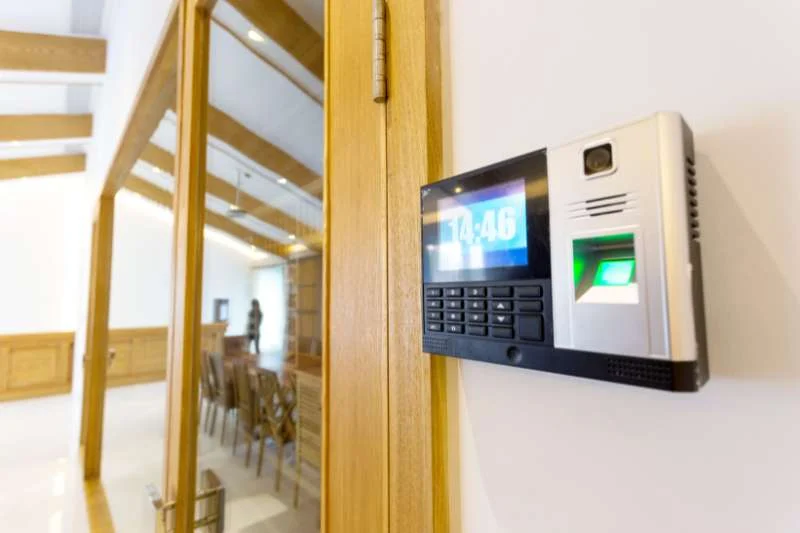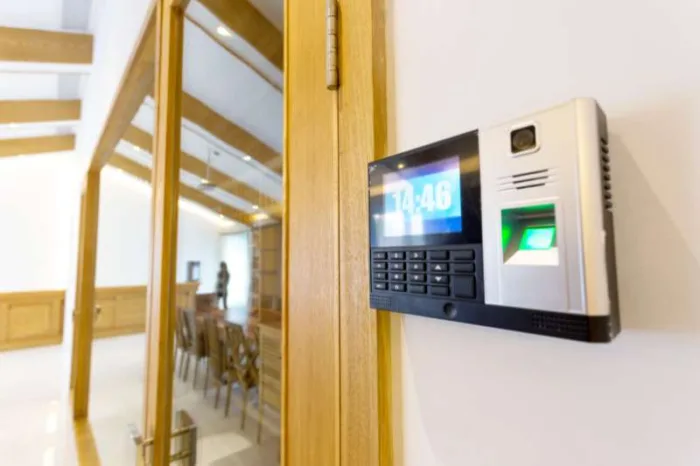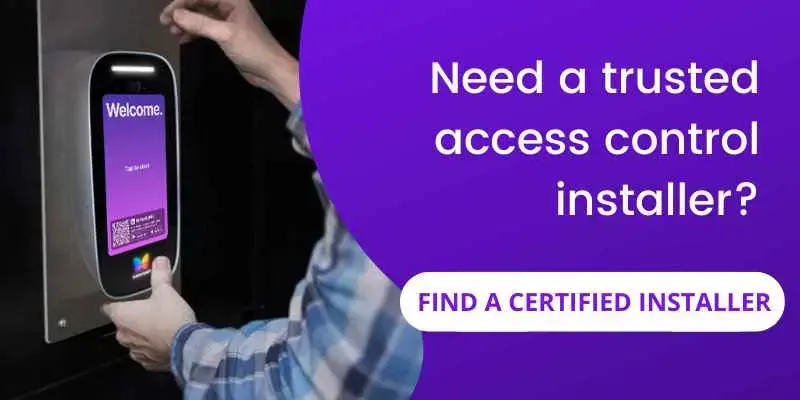Key takeaways
- For the best experience, you should hire a locksmith or certified installer for your keyless entry system.
- Keyless entry systems are worth it because they offer remote management, lower operating costs, and future-proofing.
- Choose a keyless entry system based on your property’s needs, the credentials you want, and installation requirements.
- The most common types of keyless entry systems include smart locks, keypads, and mobile-based access control.

When it comes to property access and security, keyless entry systems are an ideal fit. They eliminate the risks of physical credentials, but that’s not all. They’re also easier to use, manage, and maintain as time goes on. With that said, you should know how to install keyless entry systems. As a result, you’ll know what to expect when the time comes for installation.
In this blog, you’ll learn how to install keyless entry systems. Then, you’ll discover how to choose the right system for your property and how much installation costs. Finally, you can learn if keyless entry systems are worth it (spoiler alert: they are) and the types of door-locking systems to consider.
This post covers:
- How to install a keyless entry system
- How to find a keyless entry installer
- Is a keyless entry system worth it?
- How to choose the right keyless entry system
- Types of keyless entry door systems
How to install a keyless entry system
Keyless door entry systems can be complicated, but it depends on the type of system you choose. If you’re looking to install a property-wide solution as a property manager or owner, you’ll need professional help. dasf
Conversely, residents looking to install a smart lock for their home or apartment can often do it themselves. With that said, we encourage you to hire a locksmith for the best results.
Here’s how to install a keyless entry system based on your role:
Property managers and owners
Property managers or owners looking to install an access control solution should reach out to the system’s manufacturer. They’ll be able to find you a certified installer, ensuring your system is correctly installed, and the warranty remains valid.
With that said, it’s best you know the process of how to install keyless entry systems so that you’re better prepared.
Here’s how to install a keyless entry system, such as an access control system:
- Run wiring. First, run all the wiring necessary for your keyless entry system. Some systems require more wiring than others, but cloud-based solutions only require a minimal amount. After the wiring is installed throughout the property, it’s time to install the hardware.
- Install readers or keypads. The hardware will look different depending on the type of keyless entry system you choose. Your installer will begin with the readers or keypads to entryways. This step may take some time, depending on how many entryways the property has.
- Install electronic locks. If your property already has electronic locks, you can skip this step and connect them to the system. If not, you’ll have to replace the existing door locks with compatible electronic locks. The number of doors you have will determine how long this step takes.
- Configure system. After all the hardware is installed, the system requires configuration so it can be properly inspected and tested before onboarding property management and users.
- Inspect and test. Your installer will make sure the system is working properly before onboarding users and training property management. Installers will test every door and credential method to ensure the system works.
- Onboarding. Finally, the installer will onboard property management and staff. From the installer, staff will learn how to access the system, make changes, and more. From there, property management can onboard and train other users.
Residents
If you’re looking to upgrade your home or apartment with a smart lock, you can certainly install it yourself. For the best results, contact a locksmith to install it for you. That way, you’ll have peace of mind when it comes to your smart lock working.
Nonetheless, here is how to install a keyless door entry system for your home:
- Remove old hardware. Using the appropriate tools, remove the existing door handle, deadbolt, and strike plates from the door.
- Measure the backset. The backset is the distance from the edge of the door to the center of the hole in the door. You’ll need to know this distance to select the appropriate setting on the new smart lock. In the United States, most doors have a backset of 2 ⅜ or 2 ¾ inches.
- Install new hardware. Your smart lock will include a guide on how to install and set up the hardware. Follow the instructions for installing the hardware while using the right tools. For most, you’ll need to install the deadbolt hardware first. Then, attach the exterior faceplate, ensuring it sits flush against the door. Afterward, remove the battery plate from the interior faceplate so that you can connect the wiring. Finally, secure the interior faceplate to the door.
- Set up the lock. Insert the batteries for the lock and follow the setup instructions included.
- Install door knob and strike plates. Install the old doorknob (some purchase a new knob to match the style of the smart lock) or the new knob to the door. Then, install the smart lock’s accompanying strike plates to the door frame.
- Test the lock. Close the door to ensure it closes correctly before finally testing the lock.
How to find a keyless entry installer
For the best experience, it’s vital you know how to find a professional to install your keyless entry system. Fortunately, certified installers and locksmiths are the best solution.
Certified installers are professionals who have been trained and tested by the system’s provider or manufacturer. Through this certification process, installers know how to install the system to prevent voiding the warranty or incorrectly setting up the system.
The advantages of using a certified installer include:
- Faster installation
- Higher quality installation
- Valid warranty
To find a certified installer, go to the system manufacturer’s website or contact them directly. Then, they’ll locate a certified installer near you. Better yet, they may even send their own team of installers to handle your project.
How much does it cost to install a keyless entry system?
The cost to install a keyless entry system, such as an access control system, can vary anywhere from $500 to $2,500 per door.
Numerous factors influence the cost of installation, such as:
- Type of system or lock
- Hardware requirements
- Building size and layout
- Number of entryways
Is a keyless entry system worth it?
In short, yes, a keyless entry system is worth it because of the many benefits it provides.
Overall, a keyless entry system provides greater security by eliminating physical credentials that are easily lost, stolen, or copied. Additionally, property management and daily tasks become easier as user management is streamlined into a single process.
Rather than cutting a new metal key or replacing a door lock, property staff can now manage permissions through an online dashboard. User credentials can be added, revoked, or edited through the dashboard. Plus, an audit log helps track who is accessing what areas at what time, elevating the security of the property.
Other benefits include:
- Remote access
- Remote system management
- Lower operating costs
- Multiple credential methods
- Future-proof
What’s more, it’s possible to install a keyless entry system in a few simple steps.
Learn how to become a certified ButterflyMX installer:
How to choose the right keyless entry system
Now that you know keyless entry systems are worth it, it’s time to start your search. However, not every keyless entry system is right for your property. Before making a decision, you must consider certain factors.
Consider the following to choose the right keyless entry system:
Property needs
Every property requires some form of security, but implementation will vary drastically. So, you must identify the areas of your property that would benefit the most from keyless entry. For some properties, external door entry systems are best suited for such technologies. However, other properties may require a building-wide solution.
Installation
Your installation needs will vary depending on your building’s infrastructure and the type of system you choose. For the smoothest installation, you should choose a wireless, cloud-based system.
Rather than requiring wires throughout the entire property, wireless keyless entry systems use minimal wires. Also known as wireless door entry systems, these solutions only require three wired connections: power, internet, and door lock. As a result, you spend less time and money on a keyless entry installation.
Credentials
Next, you must consider the type of credential your keyless entry system will use. The most common keyless entry system credentials are PIN codes and mobile phones. Biometric access control credentials are also used but are much more expensive and not widely accessible. Choose a system that accepts multiple credentials for the best experience.
And if you aren’t ready to ditch physical keys altogether, consider a keyless entry system that accepts both physical and digital credentials.
Management
Overseeing and managing a keyless entry system’s credentials can consume a lot of time. That’s why you must choose a solution that’s easily manageable and remotely accessible. The right keyless entry system will give you a user-friendly web-based dashboard where you can remotely manage users, review audit logs, and more.
Above all, these actions should be accessible from anywhere. Then, the property staff can remotely manage the system on their mobile phone, tablet, laptop, or desktop.

Integrations
If your property uses any property management software, it should integrate with your keyless entry system. Otherwise, staff will spend precious time juggling between platforms to manage the property effectively.
Integrations should be a major component of any keyless entry system because integrating consolidates a lot of property management work into one place.
Maintenance
Lastly, consider the level of maintenance your keyless entry system will require.
For example, a cloud-based solution requires significantly less maintenance since software updates are rolled out remotely and require no time or effort from property management. In addition, cloud-based systems can last a lot longer because they receive updates and even new features regularly.
How much does it cost to install a keyless entry system?
The cost of keyless entry installation can vary anywhere from $500 to $2,500 per door.
Numerous factors influence the cost of installation, such as:
- Type of system
- Hardware requirements
- Building size and layout
- Number of entryways
Types of keyless entry door systems
Door locks and entry systems have rapidly developed over the years, creating a slew of different options for properties to take advantage of.
Here are the most common types of keyless door entry systems:
- Smart locks. As the most basic type of keyless door entry, smart locks are best suited for single-family homes and renters looking to upgrade their individual units. Smart locks can accept a wide array of credentials via a mobile app, keypad, Bluetooth, or Z-Wave. They can even appear as standard door knobs that only support keyless entry.
- Keypad locks. Commonly found in access control systems, keypad locks are highly sought after because of their simplicity. Keypads are often included in smart lock designs, but they’re also used with cloud-based access control systems for property-wide access.
- Mobile-based access control. Modern access control systems enable users to access their property with their mobile phones. As a result, residents can easily grant themselves or their guests access to the property using the mobile app. Property management can also remotely manage credentials from any device using the online dashboard.
- Biometric systems. While biometric lock systems are highly secure, they are more expensive and have not yet been widely adopted. However, biometric locks significantly boost security because they’re less vulnerable to tampering and other malicious methods.







